
Above: Shit be real, yo (OK not really)
“It’s like trying to compare a World War II movie to an Indiana Jones movie that’s set in World War II,” said Kevin Cloud, executive producer of the upcoming Wolfenstein sequel (just titled “Wolfenstein”), in an interview with Official Xbox Magazine. “There are very different types of actions and themes and universe considerations, and so forth.”
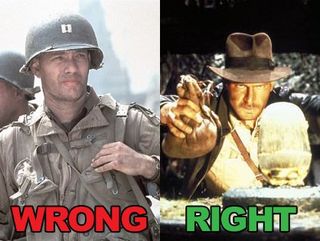
Even given those considerations, there’s a surprising wealthof historical fact (and even more pre-established fiction) behind the events of the Wolfenstein games. Before we get into them, however, there’s one thing you need to know:

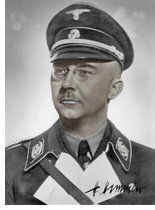
…which is probably a massive understatement, given that he’s directly responsible for the deaths of millions. Aside from being Hitler’s second-in-command, the leader of the SS and the architect of the Holocaust, Himmler is widely remembered for being obsessed with occult rituals, religious artifacts, Norse mythology and supernatural nonsense. While other Nazi leaders focused on the more practical military operations that now providethe backdrop for more “serious” WWII games, Himmler worked to turn Nazism into a quasi-religious cult based on Nordic mysticism and absurd horseshit - the perfect basis for a supernatural romp like Wolfenstein.
Whether he actually believed in it all or just liked the symbolism is up for debate, but he’s the main reason the Third Reich was so fascinated by the occult.
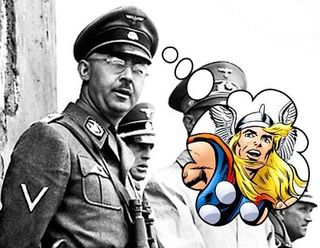
Above: Himmler thinking about the things Himmler liked to think about
More to the point, his creepy fixations are the basis for a lot of Wolfenstein’s weirdness. Heinrich I, the undead final boss of 2001’s Return to Castle Wolfenstein, was based on a 10th-century German king of whom Himmler reportedly thought he was the reincarnation. He was one of the founders of the organization that inspired Wolfenstein’s (fictional) SS Paranormal Division. And one of the major plot points in the new Wolfenstein is loosely based on one of his favorite symbols.
Himmler also hung out with Karl Maria Wiligut, an occultist and onetime mental patient who – despite being a strong believer in white-supremacist doctrine – appears to have been the namesake for Karl Viligut, a resistance fighter in Return to Castle Wolfenstein.

Above: It’s not a very good likeness, though
Some speculate that Wiligut, who advised Himmler and contributed to his various pseudoreligious beliefs, was the one who drew his attention to Wolfenstein’s most enduring symbol:

Castle Wolfenstein itself is drawn from a couple of different sources, but the most notable one is the real 17th-century castle at Wewelsburg, Germany. From 1934 to 1945, it served as the headquarters of the SS, and rumors persist that Himmler and his top lieutenants regularly performed occult rituals within its walls.

In any case, it’s frequently regarded as the centerpiece of Himmler’s occultist mania, and the SS did its level best to build up the place’s mystique with Runic decorations and mythological themes. Wewelsburg even had its own videogame appearance as a level in 2000’s Medal of Honor: Underground, which hinted at a “dark secret” that turned out to be boring old mustard gas. And while mustard gas is pretty horrific, it’s small potatoes compared to what Wolfenstein hides.

Above: Wewelsburg as seen through the blurry lens of a PSone shooter. Also there were knights in armor, which we're pretty sure aren't bulletproof in real life
While Wolfenstein 3D set its action entirely within the castle (or at least within hallways), Return to Castle Wolfenstein opened up the surrounding area (along with locales in different countries), revealing that Wolfenstein itself was nestled high in the mountains and accessible only by cable car – much like Schloss Adler in the 1968 film Where Eagles Dare. Like Wolfenstein, WED is a WWII spy adventure instead of a straight-up war story, and its assault on an alpine fortress likely provided a good chunk of the inspiration for the “new” (for 2001, anyway) Wolfenstein.
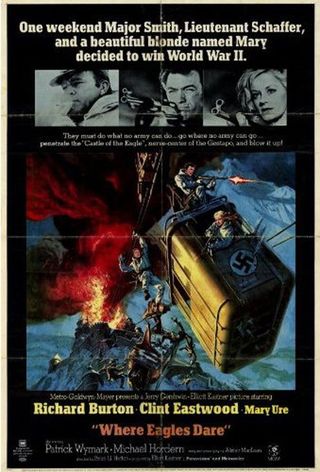

There doesn’t appear to have ever been a Third Reich program to reanimate the dead, or to harvest bodies to create undead Robocop super-soldiers, or anything like that. Still, the image of the Nazi zombie persists, fed by comics, movies and most recently the “realistic” Call of Duty: World at War.
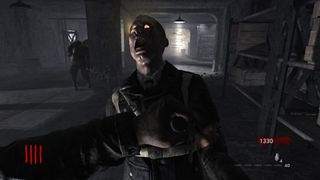
Above: REALISM!
It’s more than likely that the idea of Nazi necromancy comes in large part from the terrifying medical experiments performed in death camps. Many of them were focused on seeing how much of a given stimulus it would take to kill a person, so it’s perhaps not that big a jump to imagine that, in their most sinister laboratories, the Nazis were testing what it would take to bring those people back to life. Or failing that, horrible brain-dead un-life. Sort of like these guys:
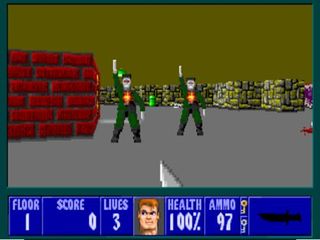

In Wolfenstein 3D’s direct sequel, BJ Blazkowicz is sent back to Germany to retrieve the Spear of Destiny, a holy relic that Hitler believes will help him conquer the world. In fact, there’s an actual historical event behind this, although the truth of it has since been muddied by the usual assortment of conspiracy theorists and sensationalist authors that weird up every little thing about the Nazis.

Above: There’s more to this than you might think
The Spear of Destiny itself (alternately called the Holy Lance, Lance of Longinus or any of several other, similar names) is, according to legend, the spear that pierced Jesus Christ’s side as he suffered on the cross. It’s since had holy powers attributed to it, and the legends that surround it say that it’s passed through the hands of a number of extremely powerful people, implying the Spear was directly responsible for their successes.
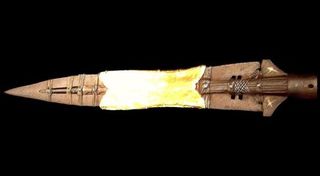
Above: Somewhat less impressive than the box art led us to believe
In truth, there are several relics that have been identified as the Spear, and one of them – a relic held by the Holy Roman Emperors and said to be forged around a nail from Jesus’ cross – actually did end up in Hitler’s possession when he appropriated it from a museum in Austria. It’s doubtful (to say the least) that he started the war in order to acquire it, as at least one author has alleged, and it’s extremely doubtful that it gave him the power to conquer the world, seeing as he sort of lost WWII.

